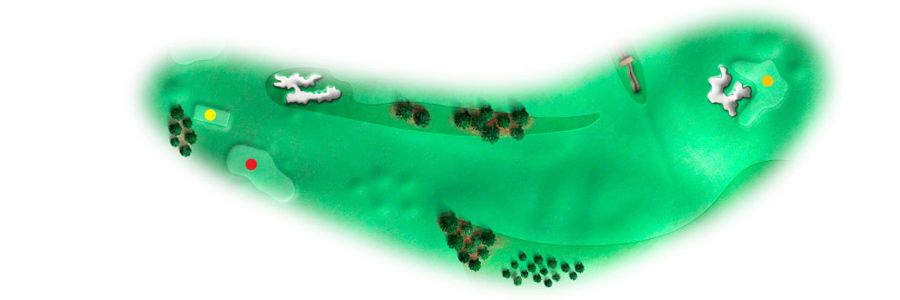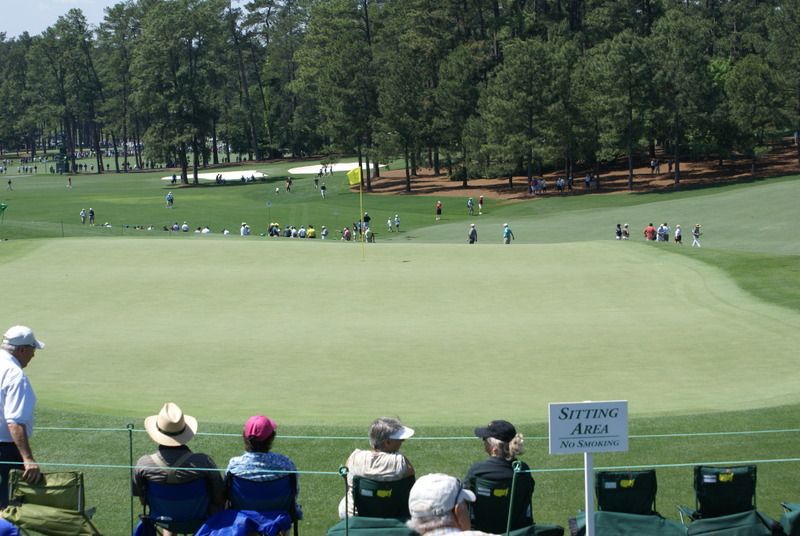With the 9th, we're leaving the section of the course that did not see television cameras for the bulk of the history of the Masters. I recall a weather delay back in the late 90's resulting in coverage of some of the holes on the front, but don't remember exactly when they went to cameras on all 18.
9th Hole - Carolina Cherry - Par 4


1934 - 420 yards - During construction Roberts had an engineer flatten a portion of the fairway to contain his drives. The non-personal architectural nature of this decision has yet to be explained. The original green was a MacKenzie horseshoe shaped specialty with a large, natural shape bunker guarding the front. The openness of the course allowed players to drive down the neighboring 1st fairway on the left to achieve a better angle to the green.
1938 - 430 yards - Roberts asked Maxell to totally redesign and debunker the green to eliminate any reward for playing down the 1st. Gone was the boomerang shape, and five new bunkers filled the left hillside, creating a distinct advantage for a drive placed on the right side. Roberts disliked the new green's "pancake appearance" telling Maxwell it looked "like something you'd expect to see on a public links."
1939 - 430 yards - Roberts requested that Maxwell add back a portion of a tongue that had existed on the front right on MacKenzie's original version of the green, thinking it should be visible from the fairway and should permit run-up shots. In the 1939 Masters, Jones' chip from behind the green rolled off the front. That summer he had the tongue flattened a bit.
1956 - 420 yards - Perhaps because the cluster of bunkers kept getting less fearsome (on was removed in 1939, another by 1951), some competitors continued to play down the first fairway. A string of trees was planted just off the front-left edge of the tee to stop this practice.
1974 - 440 yards - A horseshoe-shaped berm was added behind the green in 1972 to serve as a viewing platform that could hold 2,000 patrons. As players were driving to the bottom of the hill, the tee was moved back about 15 yards (although one writer insisted the number was closer to 40 yards). The result was a return to players fitting approaches from hanging lies on the fairway downslope.
2011 - 460 yards - As green speeds increased, the putting surface was repeatedly reduced in slope. Portions were rebuilt in 1986, 1991 and 2007, each time to create new, puttable pin placements. Despite all of the changes, the green remains as the steepest on the course. In 2001, the tee was repositioned another 30 yards back, and more mature pines were planted on the right to complicate recoveries from the pine straw.
Dan's take:
"Dr. MacKenzie described the par-4 ninth as being “of the Cape type” which, loosely translated, describes a hole with green jutting prominently in one direction, its often-elevated edges closely guarded by hazards. The description is an interesting one because while the initial ninth green did extend leftward above a large bunker, the putting surface itself was a classic MacKenzie boomerang, its two nearly symmetrical “wings” wrapped around the single, artistically shaped sand hazard. Given the famously uphill nature of the approach, this was a most distinctive green complex indeed, yet the club once again assigned Perry Maxwell the late-1930’s task of rebuilding it, resulting in the angled, three-tiered putting surface in play today. Maxwell’s initial version, by the way, featured four left greenside bunkers, but the two that have survived would likely be the only ones relevant to modern Masters participants.
An additional aspect of playing number nine has always been the downhill tee shot, for at the hole’s original 420-yard length, only longer hitters were capable of consistently driving more than 300 yards to the flat ground at the bottom, thus avoiding having to play so intimidating an approach – over a huge false front, no less – from a downhill lie. The hole was lengthened to 440 yards in 1973 and 460 in the new millennium, meaning that even though the bottom is more frequently driven today, the 340 yards necessary to reach it means that a missed tee ball can still result in a very dicey second.
Also noteworthy was the 2002 addition of trees and rough down the right side of the landing area, an attempt at minimizing the longer hitter’s ability to simply bomb it down the preferred side without a care in the world. At a glance, this might be decried as removing a strategic option – but an equally valid argument might be made that in this era of unchecked equipment, injecting some measure of accountability in this particular location was important in retaining the hole’s fundamental balance of play.
Better Then or Now?
This is largely a question of taste. The present three-level green, with its enormous back-to-front fall, requires the deftest of touches on both approaches and chips, and inevitably provides those tragic moments when a second shot, apparently well-struck, spins back just a yard too far…then agonizingly trickles some thirty yards back off the putting surface. MacKenzie’s original green, on the other hand, still featured the false front along its front-right edge (by most accounts, it was even more pronounced than at present), but also offered numerous exciting pin positions all around the boomerang. On balance, such was surely the more unique, invigorating configuration – but the present one hardly lacks for drama either."
I'm struck by the misguided efforts to prevent players from hitting to the first fairway. The safety concerns are evident, but did they need to completely change the green to accomplish this? It seems that the tree-planting that took place down the line just to the left of the tee would have sufficed, with a little patience taken to let the trees mature into a suitable obstacle. One wonders if the addition of hazards in the landing zone on the first (from the 9th tee) would have precluded that line of play, without changing the nature of the first hole.
At this point, I wanted to note the overall difference between the tournament tees (stretching to around 7,500 yards) and the member's tee (6,345 yards). On the front side alone, approximately 330 yards has been added, with only two holes (the 3rd and the 6th) playing at around the same length originally contemplated by MacKenzie and Jones. A 30 yard per hole increase actually seems small if the intent was to account for the changes in technology. But combine the added length with the narrowing of the fairways and the addition of the "second cut," and the emphasis on distance and accuracy off of the tee becomes a premium. I make no judgments on these alterations, other than to say it would have been interesting to see a better balance between these types of modifications and those that stressed the addition of strategic choices as a method to defend par. The overall theme seems to this reader to have been a move to a more penal style, with little opportunity for the player to be rewarded by a strategic choice. With the width being taken out, the player that can take advantage of the front nine is the longer player who finds the fairway, not the player that makes the best choice/execution to set up the ideal line to the day's pin.
